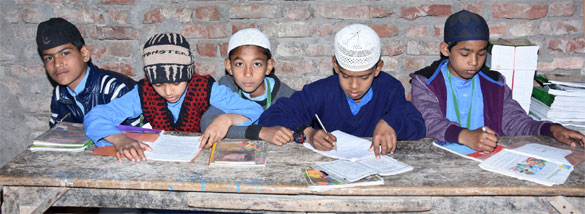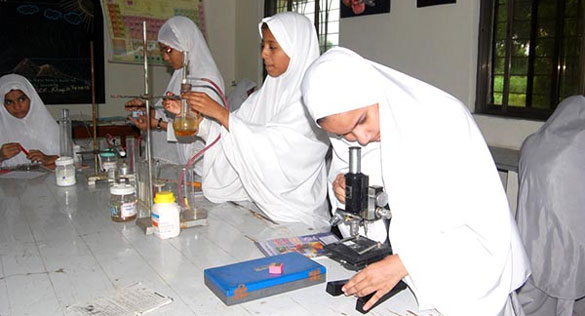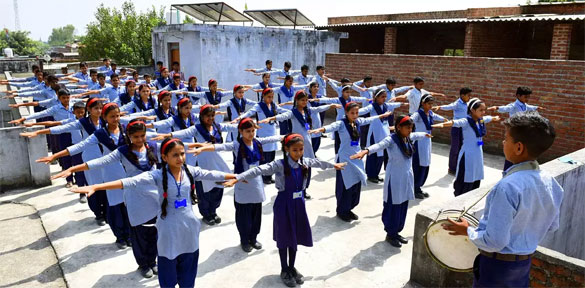
By S. Arshad, New Age Islam
05 September 2020
Madrasas are the institutions of religious learning in the Muslim world. In the context of Indian Sub-continent, we see that a parallel education system called Madrasa education system runs along the modern or secular education system regulated and funded by the government. In the early Islamic era when the English or Western education system did not exist in the orient, Madrasa were the seats of holistic education where sciences were also taught along with Quran, Hadith and Fiqh.

Introduction of residential schools for children of Muslim minorities in particular and minorities in general has resulted in a drastic change in the education priorities of poor and lower middle-class Muslim families.
-----
Thanks to this, the Islamic education system produced many scientists in almost every field of knowledge. But after the emergence of the British empire, the English or modern education system was seen by the Islamic world as an attack on Islamic culture. Since the main thrust of the western education system was on science and technology, the Muslims mistakenly regarded scientific knowledge as atheistic and anathema to Islam. Therefore, gradually, madrasas removed sciences from their curriculum and finally became the centres of religious learning.

Through the Madrasa Programme, the Tata Trusts have engaged with educational organisations working in areas with large Muslim populations
-----
In India, the first Madrasa is said to have been established in Ajmer in 1210. After that, Madrasas were established in Budaun and Delhi. In those days’ madrasas were run in mosques or in private houses. For example, Shah Waliullah's father ran a Madrasa in his house. When Shah Waliullah came back from Hijaz, Mohammad Shah Rangila presented an abandoned Haweli for his Madrasa. Initially in these Madrasas too, natural science, poetry and mathematics was taught along with Logic, Grammar, Literature, Fiqh, Tafsir, Seerat, Sufism and religious philosophy. But during the 15th century, 'acquired knowledge (Sciences) was removed from the syllabus of the madrasas. Thence, they became pure Islamic madrasas.
In India after the British occupation, initially, the British government patronised both Madrasas and Sanskrit schools called Tol. They even established Madrasa Aliah in Calcutta in 1781 to win the confidence of the Muslims. In this Madrasa, English, Logic and Philosophy were compulsory subjects along with Islamic Studies.

Many madrasas also have girl students. In this photo, girl students busy in Chemistry practical session at Madrasa Aisha Siddiqua Mansoora Malegaon. (Photo: ummid.com
-----
But when Lord Macaulay presented his theory of westernisation of the Indian culture, Muslims became alert. Lord Macaulay had written:
"We are going to introduce an education policy of ours. After getting educated under this policy, though they will remain Indian in colour and caste, they shall be considered a British in culture, civilisation and custom".
After this, the British government discouraged Madrasa system and promoted modern secular education system with emphasis on science and technology. This inspired Sir Syed Ahmad Khan in 1864 to establish AMU where the Muslims could acquire modern education without being influenced by the western culture. This created a reaction among the Muslims that Sir Syed was leading Muslims towards western culture through English education which would lead Muslims towards moral degradation and towards kufr.
Therefore, to save the Muslims of India from the English education of Sir Syed, Maulana Qasim Nanautawi established Darul Uloom Deoband just after three years in 1867. English was barred from the syllabus of Darul Uloom and Philosophy was accorded less importance. Gradually, Darul Uloom Deoband became a centre of Islamic learning and thousands of madrasas in the present-day India, Pakistan and Bangladesh were affiliated to it.
However, after the Independence, the three countries adopted a dual education policy. One, Madrasa education system where only religious education was imparted and the other was the modern or secular education system imparted in schools funded and regulated by the government. This is where the confusion lies.

Modern madrasa-cum-schools in UP combine Quran with computers/ Photo redit Nitin Sharma
------
India is a Hindu majority country and the presence of madrasas has found some justification in the fact that the government run schools do not impart religious education which is mandatory for Muslims. But that madrasas have existed and flourished in Islamic countries like Pakistan and Bangladesh underlines the confusion of the policymakers of these two countries. In Pakistan, madrasas affiliated to Deoband and Bareilly schools of thought exist though in government schools there, Islamic education is compulsory till the 12th grade. From graduate level many colleges and universities have faculties for Islamic studies. Recently, the government of Punjab has made it mandatory for Muslim college students to learn the Quran with Urdu translation.
Therefore, Muslim students will have to pass the paper on Quran to get the degree. Apart from that, a number of private Islamic universities are running in Pakistan where Islamic Studies is offered for MA and doctoral programs. Now the question arises: When Islamic studies are mandatory from grade 1 to the graduate level, what is the relevance and justification of the parallel education system of madrasas in Pakistan.
In Bangladesh, the situation is more confusing. Here three education systems run parallel. One is the general or secular schools funded and regulated by the government. Two, the Alia Madrasas on the lines of Madrasa Alia of Calcutta. Three, Qaumi madrasas which are not regulated or funded by the government and run on donations. They are not regulated by the government and their degrees are not recognised. Most of the cases of sexual abuse, physical torture and corruption are reported from these Qaumi madrasas. These madrasas follow the syllabus of Deoband and do not give importance to sciences. Alia madrasas include sciences, arts and philosophy in its syllabus.
In Bangladesh too, a number of government run universities offer Islamic Studies. Apart from them, a number of Islamic universities are functioning.
In 1977, the world conference on Islamic education was held in Makkah. One of the recommendations unanimously made in the conference was to introduce an integrated and unified Islamic education policy for the whole Muslim world replacing the existing dual education system and to put emphasis on science and technology. From 1977 to 1990, similar world conferences on Islamic education were held in Dhaka, Islamabad, Kuala Lumpur, Jakarta, Cape Town, Cairo and Khartoum. But as we see today, nothing has been done towards the formation of a unified and integrated education policy at least in Bangladesh, India and Pakistan.
The reasons for this are many. But the main reason is the sectarian differences among the Muslim religious leadership. The madrasas are affiliated to different schools of religious thought. The differences are so intense that every sect considers all the others Kafir and each sect promotes and propagates its ideology among its students and followers.
The second reason is that integration of the education policy will end the power of the Ulema and they will lose their status as the leader of their respective sects and the financial bounties these madrasas offer them. When the madrasas are merged with the mainstream schools and the subjects taught in madrasas are also offered in schools and colleges, they will have to qualify in the exams as teachers and will have to conform to the rules and regulations. Therefore, they will lose the status, financial gains and authority they enjoy now.
With the withering away of madrasas, the radicalisation of Muslim youth will stop as they will follow a national syllabus. The Madrasa in Bangladesh and Pakistan have been hotbeds of extremism and terrorism because they have their own syllabus which is based on radical ideology. Some Madrasas of Pakistan are called hotbed of terrorism or the University of jihad because they openly teach and preach extremism and militantism.
For example, Darul Uloom Haqqania, Pakistan is called the University of jihad while Jamia Uloom Islamia is described as the "fountainhead of Deobandi militancy" because they have given birth to terrorist organisations like Harkat ul Mujahideen, Jaish-e-Mohammad and Sipah-e-Sahaba. Taliban derives its name from the Persian word Taliban meaning students (of Madrasa). Madrasas along the Afghanistan border are particularly the seat of militantism.
This is why unified and integrated education policy could not be formed and implemented in India, Pakistan and Bangladesh. The Madrasa lobby will never agree on the merger of madrasas with the mainstream education system because their political, social and economic interests are protected by madrasas. Until a unified education system is implemented in these countries, the exploitation of our youth will continue and the Muslim world will continue to suffer the scourge of extremism and terrorism.
Related Articles:
New Age Islam, Islam Online, Islamic Website, African Muslim News, Arab World News, South Asia News, Indian Muslim News, World Muslim News, Women in Islam, Islamic Feminism, Arab Women, Women In Arab, Islamophobia in America, Muslim Women in West, Islam Women and Feminism

No comments:
Post a Comment